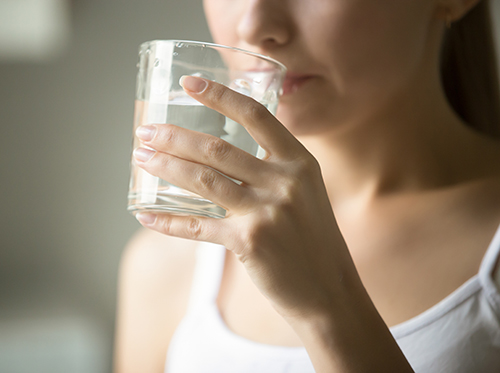February 9th, 2022

From a student handing out sweets for her classmates to an older married couple exchanging boxes of candy, Valentine’s Day is the time of year when people like to show affection by gifting sugary treats to their loved ones. Whether you’re on the giving or receiving end of Valentine’s Day candy, you can celebrate the holiday in a healthier way by making dark chocolate your confection of choice.
Contribute to Your Health
According to the Cleveland Clinic, studies have shown that the cocoa beans used to make chocolate contain flavonoids, which can help protect the body against damage from various toxins. Flavonoids may also help lower blood pressure and improve blood flow to the heart and the brain. Dark chocolates typically contain a higher amount of flavonoids than other types, making them a great choice for chocolate lovers. However, you should keep in mind that many companies produce chocolate that is so heavily processed that the flavonoids are largely eliminated. Your best bet is to look for high-quality dark chocolates and cocoa powders that have undergone minimal processing.
Protect Against Cavities
If you think there’s no way candy could ever be beneficial for your teeth, think again. The Texas A&M Health Science Center has reported that the tannins present in cocoa beans may actually help prevent cavities by interfering with bacteria’s harmful interaction with teeth. Just like with flavonoids, tannins have been found to be present more often in dark chocolates, rather than milk chocolates, giving you another great reason to choose the richer, sweet varieties.
Avoid a Sticky Situation
One more benefit of choosing chocolate over other candies is that it is less likely to get stuck in the crevices and spaces between teeth. Gooey sweets like taffy can stay lodged in the mouth for longer periods of time, putting you at a greater risk for developing cavities. When you choose your chocolate, be sure to avoid types that also contain sticky ingredients like caramel or marshmallow, and instead opt for the plain varieties.
Remember that the health benefits you can receive from dark chocolate are largely based on eating the candy in moderation. With that being said, it’s easy to make this delicious and health conscious switch when you’re out shopping for your sweetheart, friends, loved ones, and yourself. Have fun satisfying your sweet tooth this year and Happy Valentine’s Day from all of us at Ashland Dental Care!
February 2nd, 2022

In fancy medical terms, dry mouth is known as xerostomia. It’s really just what it sounds like: a condition in which you don’t have enough saliva to keep your mouth moist. Dry mouth can be the result of certain medications you’re taking, aging, tobacco use, nerve damage, or chemotherapy.
Depending on whether you’re aware of the cause of your dry mouth, here are some simple ways to keep it at bay:
- Avoid drinks that contain alcohol or caffeine
- Avoid tobacco use, or lower your consumption of tobacco
- Floss after every meal
- Brush your teeth after every meal using a fluoride toothpaste
- Avoid foods that have a high level of salt
- Stay hydrated and drink water frequently
- Consider using a humidifier at night
If you have any questions about dry mouth and how it is affecting you, give our Ashland office a call or make sure to ask our doctor during your next visit!
January 26th, 2022

Molars are made up of canyons, caves, pits, and seemingly endless caverns that are a breeding ground for decay. The protective solution is a sealant. When done correctly, a sealant from our doctor of Ashland Dental Care can be most effective in preventing cavities.
A sealant is made up of composite (a plastic-like) material that contains bonding agents to seal to the edge of the tooth. Sealants placed on the chewing surfaces of back teeth block food from being trapped. The process in which a sealant is placed is quite precise and painless.
First the tooth is cleaned with a sodium bicarbonate (baking soda) spray. Then an acid etch is applied to “roughen up” the surface. No saliva is to touch the tooth. This will re-mineralize the area, then a repeat etching is needed. An alcohol-based liquid then dries out the area and it must remain completely dry. The sealant is placed and guided through all the caverns, pits, fissures, and grooves. It is then cured with a special light, which makes it a hard, plastic-like material.
Sealants can last for several years. It is wise to have them examined on a semi-annual basis. If there is a break in the sealant, a high risk for decay is common. If a sealant is damaged, repair is simple, painless, and quick to complete.
Who can benefit from sealants? Anyone! Children often receive sealants as routine preventive care. Adults with deep canyons with stained grooves on their teeth can also benefit from a sealant. The process is quick, painless, and does not require any anesthesia. It is an effective way to lower dental restorative costs.
An investment in dental sealants can reap great benefits as properly cared for teeth will remain cavity free. Our Ashland location is available to answer your questions so give us a call today!
January 19th, 2022

There are many reasons to choose sedation dentistry. Perhaps anxiety is an issue, or your teeth are extremely sensitive. You may have a low pain threshold, an easily triggered gag reflex, or need a lot of work done in one visit. If you think sedation dentistry might be right for you, this procedure is something we are happy to discuss before your appointment at our Ashland office.
Because your concerns and condition are unique, we will tailor your sedation to fit your specific needs. We will take a careful health history to make sure whatever medication is used is safe for you, and will not interact with your other medications or affect any medical conditions. The three most common methods of sedation include:
Our experience and training allow us to recommend a method that is specifically designed for your needs. If you would like to remain completely aware, but feel less anxious, if you would like deep sedation through the entire procedure, or if you want something in between, talk to us about your options. Whatever the reason you choose sedation dentistry, our doctor and our team are here to provide you with a skilled and safe sedation experience.




